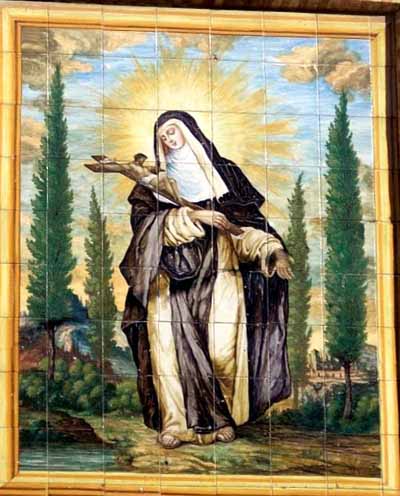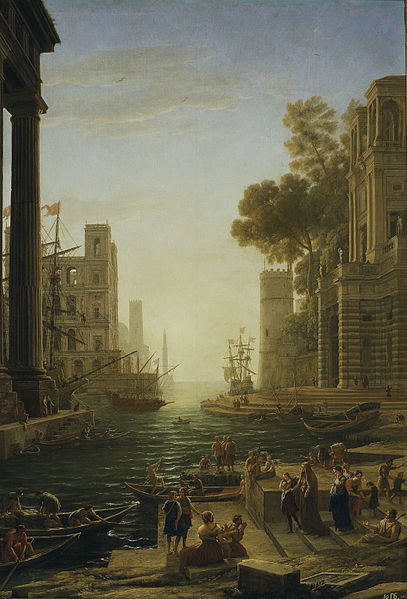St. Paula
 Born in Rome, 347; died at Bethlehem, 404. She belonged to one of the first families of Rome. Left a widow in 379 at the age of 32 she became, through the influence of St. Marcella and her group, the model of Christian widows. In 382 took place her decisive meeting with St. Jerome, who had come to Rome with St. Epiphanius and Paulinus of Antioch. These two bishops inspired her with an invincible desire to follow the monastic life in the East. After their departure from Rome and at the request of Marcella, Jerome gave readings from Holy Scripture before the group of patrician women among whom St. Paula held a position of honour. Paula was an ardent student. She and her daughter, Eustochium, studied and mastered Hebrew perfectly. By their studies they aimed not so much to acquire knowledge, as a fuller acquaintance with Christian perfection.
Born in Rome, 347; died at Bethlehem, 404. She belonged to one of the first families of Rome. Left a widow in 379 at the age of 32 she became, through the influence of St. Marcella and her group, the model of Christian widows. In 382 took place her decisive meeting with St. Jerome, who had come to Rome with St. Epiphanius and Paulinus of Antioch. These two bishops inspired her with an invincible desire to follow the monastic life in the East. After their departure from Rome and at the request of Marcella, Jerome gave readings from Holy Scripture before the group of patrician women among whom St. Paula held a position of honour. Paula was an ardent student. She and her daughter, Eustochium, studied and mastered Hebrew perfectly. By their studies they aimed not so much to acquire knowledge, as a fuller acquaintance with Christian perfection.
She did not, however, neglect her domestic duties. A devoted mother, she married her daughter, Paulina (d. 395), to the senator Pammachius; Blesilla soon became a widow and died in 384. Of her two other daughters, Rufina died in 386, and Eustochium accompanied her mother to the Orient where she died in 419. Her son Toxotius, at first a pagan, but baptized in 385, married in 389 Laeta, daughter of the pagan priest Albinus. Of this marriage was born Paula the Younger, who in 404 rejoined Eustochium in the East and in 420 closed the eyes of St. Jerome. These are the names which recur frequently in the letters of St. Jerome, where they are inseparable from that of Paula.
 The death of Blesilla and that of Pope Damasus in 384 completely changed the manner of life of Paula and Jerome. In September, 385, Paula and Eustochium left Rome to follow the monastic life in the East. Jerome, who had preceded them thither by a month, joined them at Antioch. Paula first made in great detail the pilgrimage of all the famous places of the Holy Land, afterward going to Egypt to be edified by the virtues of the anchorites and cenobites, and finally took up her residence at Bethlehem, as did St. Jerome. Then began for Paula, Eustochium, and Jerome their definitive manner of life. The intellectual and spiritual intercourse among these holy persons, begun at Rome, continued and developed. Two monasteries were founded, one for men, the other for women. Paula and Eustochium took a larger share in the exegetical labours of Jerome, and conformed themselves more and more to his direction. An example of their manner of thinking and writing may be seen in the letter they wrote from Bethlehem about 386 to Marcella to persuade her to leave Rome and join them; it is Letter XLVI of the correspondence of Jerome. But God was not sparing of trials to His servants. Their peace was disturbed by constant annoyances, first the controversy concerning Origenism which disturbed their relations with John, Bishop of Jerusalem, and later Paula’s need of money, she having been ruined by her generosity. She died in the midst of these trials and good works. The chief and almost the only source of Paula’s life is the correspondence of St. Jerome (P. L., XXII). The Life of St. Paula is in Letter CVIII, which, though somewhat rhetorical, is a wonderful production. The other letters which specially concern St. Paula and her family are XXII, XXX, XXXI, XXXIII, XXXVIII, XXXIX, LXVI, CVII.
The death of Blesilla and that of Pope Damasus in 384 completely changed the manner of life of Paula and Jerome. In September, 385, Paula and Eustochium left Rome to follow the monastic life in the East. Jerome, who had preceded them thither by a month, joined them at Antioch. Paula first made in great detail the pilgrimage of all the famous places of the Holy Land, afterward going to Egypt to be edified by the virtues of the anchorites and cenobites, and finally took up her residence at Bethlehem, as did St. Jerome. Then began for Paula, Eustochium, and Jerome their definitive manner of life. The intellectual and spiritual intercourse among these holy persons, begun at Rome, continued and developed. Two monasteries were founded, one for men, the other for women. Paula and Eustochium took a larger share in the exegetical labours of Jerome, and conformed themselves more and more to his direction. An example of their manner of thinking and writing may be seen in the letter they wrote from Bethlehem about 386 to Marcella to persuade her to leave Rome and join them; it is Letter XLVI of the correspondence of Jerome. But God was not sparing of trials to His servants. Their peace was disturbed by constant annoyances, first the controversy concerning Origenism which disturbed their relations with John, Bishop of Jerusalem, and later Paula’s need of money, she having been ruined by her generosity. She died in the midst of these trials and good works. The chief and almost the only source of Paula’s life is the correspondence of St. Jerome (P. L., XXII). The Life of St. Paula is in Letter CVIII, which, though somewhat rhetorical, is a wonderful production. The other letters which specially concern St. Paula and her family are XXII, XXX, XXXI, XXXIII, XXXVIII, XXXIX, LXVI, CVII.
LAGRANGE, Histoire de Ste. Paule (2nd ed., Paris, 1868); Acta SS., Jan., III, 327-37; see also Historia lausiaca, lxxix, in P.G., XXXIV, 1180; St. JEROME, De viris illustribus in P.L., XXIII, 719; UPTON, The House on the Aventine in Catholic World, LXVII, 633-643.
LOUIS SALTET (Catholic Encyclopedia)






